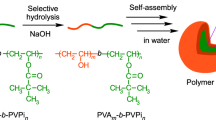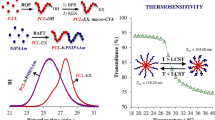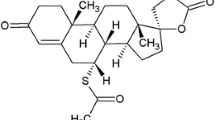Abstract
The self-assembly of polystyrene-block-poly(l-lysine) (PS-PLLys·HCl) copolymers with different block lengths has been studied in toluene. The obtained spherical micelles exhibit size variations upon addition of acids or bases, as indicated by light and neutron scattering studies. It is shown that pyridine induces a shrinking of the polystyrene chains in the corona region of the micelles, decreasing the aggregate solvent interface. The addition of benzoic acid, on the other hand, leads to a swelling of the copolymer micelles proportional to the molar fraction of polypeptide. This behavior suggests a selective permeability of the PS-PLLys micelles and the possibility to encapsulate organic compounds in toluene depending on their chemical nature.








Similar content being viewed by others
References
Förster S (1997) Amphiphilic block copolymers. Ber. Bunsenges. Phys Chem 101(11):1671–1678
Bahadur P (2001) Block copolymers—their microdomain formation (in solid state) and surfactant behaviour (in solution). Curr Sci 80:1002–1007
Langevin D (1992) Micelles and microemulsions. Annu Rev Phys Chem 43:341–369
Jakobs B, Sottmann T, Strey R, Allgaier J, Willner L, Richter D (1999) Amphiphilic block copolymers as efficiency boosters for microemulsions. Langmuir 15:6707–6711
Endo H, Mihailescu M, Monkenbusch M, Allgaier J, Gompper G, Richter D, Jakobs B, Strey R, Grillo I (2001) Effect of amphiphilic block copolymers on the structure and phase behavior of oil-water-surfactant mixtures. J Chem Phys 115(1):580–600
Holderer O, Frielinghaus H, Byelov D, Monkenbusch M, Allgaier J, Richter D (2005) Dynamic properties of microemulsions modified with homopolymers and diblock copolymers: the determination of bending moduli and renormalization effects. J Chem Phys 122:094908
Monnier A, Schüth F, Huo Q, Kumar D, Margolese D, Maxwell RS, Stucky GD, Krishnamurty M, Petroff P, Firouzi A, Janicke M, Chmelka BF (1993) Cooperative formation of inorganic–organic interfaces in the synthesis of silicate mesostructures. Science 261:1299–1303
Hecht E, Hoffmann H (1994) Interaction of ABA block copolymers with ionic surfactants in aqueous solution. Langmuir 10:86–91
Nordskog A, Egger H, Findenegg GH, Hellweg Th, Schlaad H, von Berlepsch H, Böttcher C (2003) Structural changes of diblock PB40 PEO62 -copolymer micelles induced by addition of low molecular weight surfactants: Scattering and cryo-TEM studies. Phys Rev E 68:11406
Fütterer T, Hellweg Th, Findenegg GH, Frahn J, Schlüter AD, Böttcher C (2003) Self-assembled structures formed by amphiphilic polyparaphenylenes in the bulk, at the water/air interface and in non-ionic surfactant solutions. Langmuir 19:6537–6544
Nordskog A, Fütterer T, Schlaad H, Heinemann A, von Berlepsch H, Böttcher C, Hellweg Th (2004) Formation of mixed micelles of PB40PEO62 and the anionic surfactant SDS in aqueous solution. Phys Chem Chem Phys 6:3123–3129
Bates FS, Fredrickson GH (1990) Block copolymer thermodynamics: theory and experiment. Annu Rev Phys Chem 41:525–557
Gil ES, Hudson SM (2004) Stimuli-responsive polymers and their bioconjugates. Prog Polym Sci 29(12):1173–1222
Lecommandoux S, Achard M-F, Langenwalter JF, Klok H-A (2001) Self-assembly of rod-coil diblock oligomers based on α-helical peptides. Macromolecules 34:9100–9111
Matsumura Y (2008) Poly (amino acid) micelle nanocarriers in preclinical and clinical studies. Advanced Drug Delivery Reviews 60:899–914
Ponsinet V, Fabre P (1996) Flexibility of the membranes in a doped swollen lamellar phase. J Phys Chem 100:5035–5038
Wang Y, Chang Y (2003) Synthesis and conformational transition of surface-tethered polypeptide: poly(l-lysine). Macromolecules 26:6511–6518
Sigel R, Losik M, Schlaad H (2007) pH responsiveness of block copolymer vesicles with a polypeptide corona. Langmuir 23:7196–7199
Orts Gil G, Losik M, Schlaad H, Hellweg T (2008) Properties of pH-responsive mixed aggregates of polystyrene-block-poly(l-lysine) and nonionic surfactant in solution and adsorbed at a solid surface. Langmuir 24:12823–12828
Schlaad H, Smarsly B, Losik M (2004) The role of chain-length distribution in the formation of solid-state structures of polypeptide-based rod-coil block copolymers. Macromolecules 37:2210–2214
Berne BJ, Pecora R (1976) Dynamic light scattering. Wiley, New York
Provencher SW (1982) A constrained regularization method for inverting data represented by linear algebraic or integral equations. Comput Phys Com 27:213–217
Hellweg T, Brûlet A, Sottmann T (2000) Dynamics in an oil-continuous droplet microemulsions as seen by quasielastic scattering techniques. Phys Chem Chem Phys 2(22):5168–5174
Provencher SW (1976) A Fourier method for the analysis of exponential decay curves. Biophys J 16:27–41
Provencher SW (1982) CONTIN: a general purpose constrained regularization program for inverting noisy linear algebraic and integral equations. Comput Phys Com 27:229–242
Einstein A (1956) Investigation on the theory of the Brownian movement. Dover, New York
Thomas JC (1987) The determination of log normal particle size distributions by dynamic light scattering. J Colloid Interf Sci 117:187–192
Diamond S, Dolch W (1972) Generalized log-normal distribution of pore sizes in hydrated cement paste. J Colloid Interface Sci 38:234–244
Rübe A, Hause G, Mäder K, Kohlbrecher J (2005) Core-shell structure of Miglyol/poly(d, l-lactide)/poloxamer nanocapsules studied by small-angle neutron scattering. J Controlled Release 107:244–252
Mes E, Kok W, Poppe H, Tijssen R (1999) Comparison of methods for the determination of diffusion coefficients of polymers in dilute solutions the influence of polydispersity. J Polymer Sci Part B: Polym Phys 37:593–603
Vink H (1985) Mutual diffusion and self-diffusion in the frictional formalism of non-equilibrium thermodynamics. J Chem Soc Faraday Trans I 81:1725–1730
Evans D, Wennerström H (1994) The colloidal domain: where physics, chemistry, biology, and technology meet. VCH, New York
Bachman M (1999) RCA-1 silicon wafer cleaning. Technical report, INRF, California
Keiderling U (2002) The new BerSANS-PC software for reduction and treatment of small angle neutron scattering data. Appl Phys A Mater Sci Process 74:1455–1457
Guinier A, Fournet G (1955) Small-angle scattering of X-rays. Wiley, New York
Glatter O, Kratky O (1982) Small angle X-ray scattering. Academic, London
de Gennes P-G (1979) Scaling concepts in polymer physics. Cornell University Press, Ithaca
Hellweg Th, Schemmel S, Rother G, Brûlet A, Eckerlebe H, Findenegg GH (2003) Demixing dynamics of a binary liquid mixture in a controlled pore glass. Eur Phys J E 12:S1–S4
Pedersen JS, Gerstenberg MC (1996) Scattering form factor of block copolymer micelles. Macromolecules 29:1363–1365
Kohlbrecher J (2008) SASfit: a program for fitting simple structural models to small angle scattering data. Paul Scherrer Institut, Laboratory for Neutron Scattering, Villigen
Svaneborg C, Pedersen JS (2001) Block copolymer micelle coronas as quasi-two-dimensional dilute or semidilute polymer solutions. Phys. Rev. E 64(1):10802–10805
Iatrou H, Hadjichristidis N, Meier G, Frielinghaus H, Monken-busch M (2002) Synthesis and characterization of model cyclic block copolymers of styrene and butadiene. Comparison of the aggregation phenomena in selective solvents with linear diblock and triblock analogues. Macro-molecules 35(14):5426–5437
Khlebtsov NG (2003) On the dependence of the light scattering intensity on the averaged size of polydisperse particles: comments on the paper by M. S. Dyuzheva et al. (Colloid J2002, vol. 64, no. 1, p. 39). Colloid Journal 65(5):652–655
Burchard W, Richtering W (1989) Dynamic light scattering from polymer solutions. Prog Colloid Polymer Sci 80:151–163
Orts Gil G (2008) Self-assembly and dynamics of complex amphiphilic systems: from block copolymers to phospholipids. Ph.D. thesis, Technische Univer-sität Berlin, Stranski-Laboratorium für Physikalische Chemie, Berlin.
Sun T, Teja A (2004) Density, viscosity, and thermal conductivity of aqueous benzoic acid mixtures between 375 K and 465 K. J Chem Eng Data 49:1843–1846
Chipman J (1924) The solubility of benzoic acid in benzene and in toluene. J Am Chem Soc 46:2445–2448
Acknowledgments
We wish to thank the DFG (Sfb 448, TP A12, and BIOSONS) for financial support. T.H. also would like to acknowledge financial support from the Sfb 481 (TP A15).
Author information
Authors and Affiliations
Corresponding authors
Appendices
Appendix A: additional sample parameters
Average molecular volumes of the polymers and the PLLys and PS blocks are displayed in Table 4. Assuming monomeric micelles with a dense PLLys core and a PS shell, the PLLys cores having volumes lying between 12 and 30 nm3 would fit into spheres of radii between 1.4 and 2 nm, and the whole “dry” polymer would fit into spheres of radii between 2.4 and 2.9 nm.
Appendix B: scattering length densities and molecular volumes
The values from Table 5 were used for the fits. From Tables 4 and 5, we can calculate the average SLD of the whole polymers, at 1.31, 1.25, and 1.27·10 l0 cm−2. The average value of 1.3·10 l0 cm−2 will be used.
Rights and permissions
About this article
Cite this article
Orts Gil, G., Prévost, S., Łosik, M. et al. Polypeptide hybrid copolymers as selective micellar nanocarriers in nonaqueous media. Colloid Polym Sci 287, 1295–1304 (2009). https://doi.org/10.1007/s00396-009-2096-y
Received:
Revised:
Accepted:
Published:
Issue Date:
DOI: https://doi.org/10.1007/s00396-009-2096-y




